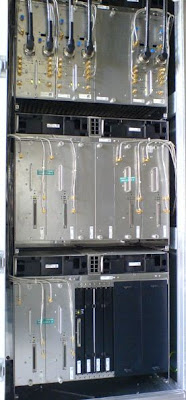BTS (Base Transceiver Station) is a devices/equipment that
the wireless communication between the mobile station (MS) and a network
allows. The network is possible that one of the wireless communication
technologies like GSM, CDMA, Wireless Local Loop ,
WAN, WiFi, WiMAX, etc. BTS is also called the radio base station (RBS), node B
(in 3G networks), or simply the base station (BS). For a discussion of the LTE
standards the abbreviation eNB for Evolved Node B is widespread.

Although the term BTS can for each of the wireless communication standards, it is generally associated with mobile communication technologies such as GSM and CDMA. In this regard, forms a BTS part of the base station subsystem (BSS) to the developing for system administration. It can also devices for encrypting and decrypting communications, spectrum filtering tools (band-pass filter), etc. BTS antennas as components generally considered sense, because they facilitate the functioning of the BTS.
Typically a BTS have several transceivers (TRX), which can serve at different frequencies and different sectors of the cell (in the case of sectorized base stations). A BTS controlled by a parent base station controller via the base station control function (BCF). The BCF is implementing as a discrete unit or even incorporating in a TRX in compact base stations. The BCF provides an operations and maintenance (O & M) connection to the network management system (NMS), and manages the operating states of each TRX, as well as software handling and alarm collection. The basic structure and functions of the BTS remains the same regardless of the wireless technologies.
A BTS in general consists of the following parts:
Transceiver (TRX)
Are generally referred to as the driver receiver (DRX), DRX
are either in the form of the single (STRU), double (dTRU) or a composite
material double radio unit (DRU). It does the sending and receiving signals. It
also includes sending and receiving signals to and from higher network units
(as the base station in mobile radio controller).
Power amplifier (PA)
Amplifies the signal from DRX for transmission by the
antenna can be integrate with DRX.
Combiner
Combines feeds from several DRXs so that they will be sent
out via a single antenna. Allow a reduction in the number of antenna.
Duplexer
For the separation of transmit and receive signals to / from
the antenna. Is capable of send and receive signals via the same antenna ports
(cable to the antenna).
Antenna
This is the structure that lay at the upper the BTS. it can be installed,
as it is or in any way disguised (Concealed cell-sites).
Alarm System Expansion
Collects working status alarms from various units in the BTS
and extends them to operation and maintenance (O & M) stations.
Control function
Controls and manages the various units of the BTS, including
any software. On the on-site configurations, status changes, software upgrades,
etc. done by the control function. Baseband reception unit (BBxx), Frequency
hopping, signal DSP, etc.
Diversity Techniques
To improve the quality of the received signal, often two
receive antennas are use, arranged at an equal distance to an odd multiple of
one-quarter wavelength (900 MHz, the wavelength is 30 cm). This technology,
antenna diversity and spatial diversity known, avoids disruption caused by
fading. The antennas could arrange horizontally or vertically. Horizontal
distance requires complex installation, but provides better performance. Unlike antenna or space diversity, there are other diversity
techniques such as frequency / time diversity, antenna pattern diversity,
polarization diversity and. Divide refers to the tensile force in a particular area of
the cell, as a sector known. Each field can be considering as a new cell.
Directional of antennas can reduce interference. If not
sectorized, the cell will be served by an omnidirectional antenna, which
radiates in all directions. A typical structure is the trisector, also known as
clover known in which it serves three sectors separated antennas. Each sector
has a separate direction of tracking, typically of 120 ° with respect to the
adjacent. Other orientations are used to local conditions to be adjusting.
Bi-sectored cells are also implementing. These are most often associated with
the antenna sectors are separated by 180 degrees are aligned, but also local
differences do not exist.

